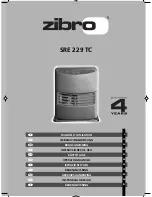
3.6 Starting and stopping
To Start
The start-up operation must be performed by
qualified engineer, after making sure that the
components of the plant have been installed
properly and that all the safety devices have
been adjusted correctly.
The first start-up consists of the following:
• Close the room thermostat contact: the
burner will start the operating cycle and,
after the pre-purge cycle, the flame will be
ignited
• Check that the fan starts about 1 minute
after the flame is ignited
• Check the combustion parameters
• Wait for the heater to reach full
temperature (20 min.) And make sure that
the limit thermostat does not intervene
• Open the room thermostat contact and
make sure that the burner stops
• Close the room thermostat contact again
and perform a new burner ignition cycle
• Close the fuel shut-off valve and make sure
the burner stops
During the first start-up cycle, the burner
may stop due to the lack of fuel supply. In
this case, wait at least 30 seconds and, after
resetting the burner by pressing the dedi-
cated button, repeat the operation.
During the first few hours of operation, it
is common for fumes and odours to form
due to the heating of paints and seals. The
smell will fade by itself within a few hours,
but if it continues for a prolonged period of
time, please contact the manufacturer. It is
recommended to ventilate the room during
this time.
To Stop
To stop the air heater, use the room ther-
mostat only, by setting it to the minimum
temperature or by opening the contact of
the switch itself —if present— or on stop.
Wait for the fan to stop (4 min.) and then,
if necessary, turn the power off from the
main switch.
Never stop the appliance by cutting off the
electrical power, the thermal energy stored
in the heat exchanger may cause danger-
ous overheating situations, with possible
damage to the air heater.
Moreover the ‘LIMIT’ thermostat could be
triggered and it might be necessary to release
it manually.
3.7 Inspections
In order to ensure that the heater works
properly, some basic parameters should
be checked.
Turn the unit on and:
• Make sure that the fan unit starts within 60
seconds after the burner is turned on.
With the unit steady (after an approximate 20
minutes of continuous use) perform the following
operations:
• Make sure there are no fuel leaks.
• Check the correct fuel flow rate by weighing
the diesel fuel or reading the gas meter
• Check that the unit's flue gas temperature
and the technical data are similar with a
tolerance of ± 10°C.
• Make sure that the manual resetting safety
thermostat calibration is correct.
• Check that the temperature near the safety
thermostat is correct (ambient temperature
+ air temperature).
• Check that no faults have been reported on
the safety thermostat.
• Check that no faults have been reported on
the safety devices present on the machine.
• Make sure that the temperature gradient is
compliant to the value specified in Table 2
on page 9 with a ±2°k tolerance.
• Re-activate the appliance. Simulate the
intervention of the safety thermostat and
check that the burner turns off. Do not
adjust the factory settings
• Check that the fan electric absorption value
does not exceed the value specified in the
plate.
• Check that the air pressure switch on the
burner is properly calibrated so that it will
turn the burner off in case of an insufficient
flow of combustion air.
• Make sure that the fan operates for another
3/4 minutes after the burner has been
turned off, before it stops.
All of the aforementioned checks must be
carried out. If you want to control the flame
through the flame viewer, you must remove
the threaded plug and make sure that you
wear protective eye-wear.
3.8 Condensation check
The appliance is designed to be operated
with the heating capacity and the air flow
rate specified in the Data Sheet section.
If the heating capacity is too low and/or
the air flow rate is too high, combustion
products may condensate, resulting corro-
sion of the heat exchanger.
Check inside of the heat exchanger for
condensation.
This check should be performed by turning
off the burner after half an hour of continu-
ous use, checking simultaneously through
the flue connection if there is any trace of
humidity in the flue gas collector and in the
flue gas pipe elements.
There should not be leakage coming from
the safety condensate discharge.
3.9 Indicators
Voltage presence indicator
Placed on the electric panel, it is a green
light indicator, which turns on when there
is a voltage.
Safety devices signaller
Positioned on the electrical panel, consist-
ing of a red indicator which lights up when
one of the appliance's safety devices has
intervened.
Burner lock indicator
Located on the burner, is a red light indicator,
which will turn on when the burner is in
lockout.
3.10 Fan electric absorption
To measure the electrical absorption of the appli-
ance motor, proceed as follows:
• Insert the current meter on a phase of the
main supply line;
• Set the heater for operation in summer
mode, so as to exclude all other devices
(burner and auxiliaries);
• Read the electric absorption value on the
current meter and compare it with the data
written on the fan plate.
25








































